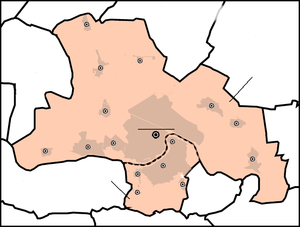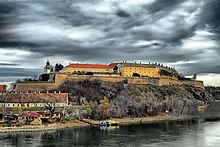Novi Sad
![]()
This article is about the city in Serbia. For the band, see Novi Sad (band).
Novi Sad (Cyrillic Нови Сад [ˈnɔ̂viː ˈsâːd] ![]() ; German Neusatz; Hungarian Újvidék; Slovak Nový Sad) is the second-largest city in Serbia, the capital of Vojvodina and administrative centre of the Južna Bačka Okrug.
; German Neusatz; Hungarian Újvidék; Slovak Nový Sad) is the second-largest city in Serbia, the capital of Vojvodina and administrative centre of the Južna Bačka Okrug.
The university city consists of the districts Novi Sad north of the Danube and Petrovaradin at the foot of the fortress of the same name south of the Danube. According to the 2011 census, the city has 231,798 inhabitants. The greater Opština Novi Sad area has a population of 341,625. The city is located at an altitude of 72 to 80 meters above sea level. In Novi Sad, the Small Batschka Canal (as part of the Danube-Tisza-Danube Canal System) flows into the Danube. The city is also called Serbian Athens.
.jpg)
St. Mary's Church in the city centre

Freedom Bridge over the Danube


Map of Ratzenstadt from 1745

Petrovaradin Fortress
.jpg)
City Hall
History
Medieval
The village was established in the late Middle Ages in the densely populated county of the Kingdom of Hungary by the construction of the Cistercian monastery of Belefons as a so-called ecclesiastical village. In 1526 it was conquered by the Ottomans. Their 150-year rule led to the devastation and depopulation of the Pannonian Plain. Nomadic southern Slavs tolerated by the Ottomans took over existing settlements or founded new ones. However, the turbulence of the time generally did not allow for sustainable settlements. According to Ottoman records (Defter) from 1590, 105 Slavic families lived in present-day Novi Sad.
Habsburg Monarchy
After the victory of the Austrians against the Ottomans (1697) under Prince Eugene at Zenta (Serbian Senta) and the subsequent peace treaty of Karlowitz (1699), the Ottoman Empire had to cede the Batschka to Austria. After the publication of the Imperial Impopulation Patent ("... for the better Auffhelfung, again elevation and population of the same") an immediate new settlement of the Batschka was planned on the part of the Viennese Court Chamber, which, however, was soon postponed due to the priority of the military border (Pantschowa, Temeswar etc.).
As early as 1694, the Austrian military administration had established a bridgehead on the opposite bank of the Danube from the Peterwardein fortress, around which a settlement of soldiers, craftsmen and merchants grew up, initially called Racka Varoš. In German, the settlement was called Ratzenstadt, meaning Serbian town, because Raizen, Ratzen or Rac was an earlier German and Hungarian name for the Serbs, the inhabitants of Raszien. Later the settlement was called Peterwardeiner Schanze. Around this bridgehead a settlement with about 1000 Slavic inhabitants developed, today's Old Town. In the early years it was mainly Serbs, because in the opposite fortress Peterwardein (Serbian Petrovaradin) only Catholics were allowed to settle.
In 1716 the Ottomans were again in front of Neusatz, but were defeated by Prince Eugene in the battle of Peterwardein.
Royal Free City Neoplanta
On 1 January 1748 Empress Maria Theresa granted the city the rights of a "royal free city" (libera regia civitas) and named it (Latin.) "Neoplanta". ("Nominentur Neoplanta", let us call it Neoplanta from now on), Hungarian: Új-Vidégh, German: Ney-Satz. Later the place was called Serbian Novi Sad and Bulgarian Mlada Loza
Rumour has it that the craftsmen and merchants bought the status of Free Imperial City from the Empress for 80,000 forints, as they no longer wanted to be residents of a military settlement but citizens of a free trading city.
Novi Sad quickly developed into an economic and above all cultural centre of the Serbs. In 1765 the first Serbian Orthodox seminary was established. There are 17 Serbian Orthodox monasteries in the Fruška Gora National Park opposite. In 1810, the first Serbian high school was opened in Novi Sad. Vuk Stefanović Karadžić wrote in 1817 that Novi Sad was the largest Serbian city in the world. In 1820, Novi Sad had 20,000 inhabitants, two-thirds of whom were Serbs.
Novi Sad was a location of the Imperial and Royal Army. Army, here were stationed the III Battalion of the Infantry Regiment No. 20, the IV Battalion of the Infantry Regiment No. 6 as well as parts of the k.k. Landwehr Infantry Regiment No. 32 were stationed here. At the beginning of the 20th century, Germans were the third largest population group in the town after Hungarians and Serbs.
Kingdom of Yugoslavia
After the end of the First World War, the area around Novi Sad fell to the newly established Kingdom of Serbs, Croats and Slovenes, which called itself the Kingdom of Yugoslavia from 1929.
Second World War
In the period from 1941 to 1945, the city was occupied by the Kingdom of Hungary, which belonged to the Axis powers. In Novi Sad, from 21 to 23 January 1942, the Hungarian commander General Ferenc Feketehalmy-Czeydner had 1246 civilians shot, among them 809 Jews, 375 Serbs, 8 Germans and 18 Hungarians. Several hundred civilians were thrown under the ice of the frozen Danube and drowned. After the partisans moved in at the end of 1944, almost the entire remaining German-speaking population, which had not fled by then, was expelled or murdered.
NATO bombings
Novi Sad was the target of NATO air strikes during the Kosovo war in 1999, during which all the Danube bridges, the regional water supply (which supplied 600,000 people), the radio station and the refinery were destroyed. Furthermore, the city hospital, several primary schools, a day-care centre and several crèches were damaged by the bombs.
For more than six years, traffic across the Danube was handled by a pontoon bridge that was only opened to ships three times a week. Since the reopening of the so-called Freedom Bridge on 11 October 2005, navigation is once again unhindered.
.jpg)
Since 2000, the single-track temporary bridge has replaced the Žeželj Bridge on the Belgrade-Budapest route in Novi Sad, which was destroyed by bombing in 1999.
Sports
The largest sports club in Novi Sad is the football club Vojvodina Novi Sad. It plays in the SuperLiga, the highest division in Serbian football. Vojvodina celebrated its greatest successes in Yugoslavian football. It was Yugoslavian champion in 1966 and 1989.
Search within the encyclopedia